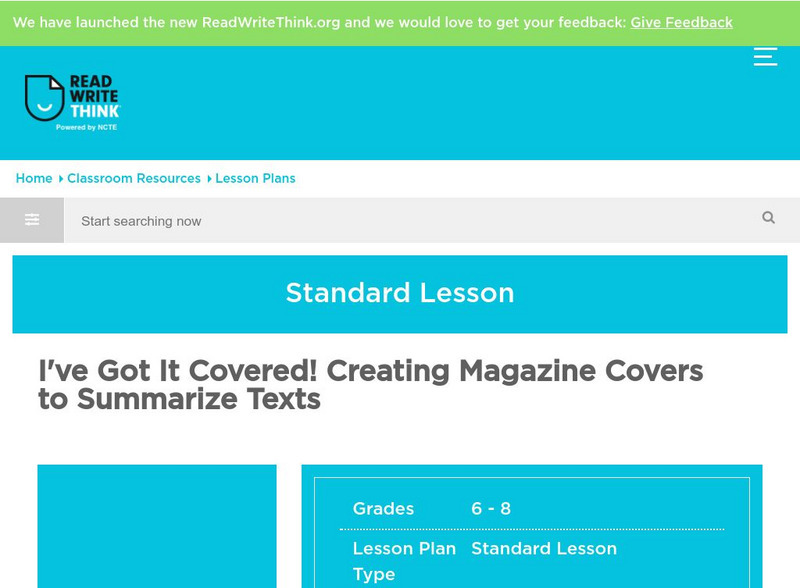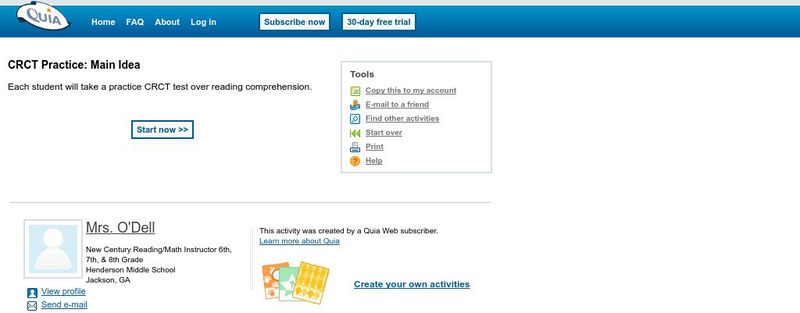Curated OER
Battle of Lexington and Concord
Eleventh graders study the causes of the American Revolution. In this American History lesson, 11th graders read a story "Guns for General Washington. Students read and discuss statements about war.
Curated OER
Surrender at Yorktown
Eighth graders examine the start of the American Revolution. In this American History lesson, 8th graders analyze primary sources. Students prepare a narration of events leading up to the revolution.
Curated OER
Recognizing Lifestyle Changes
Students discuss the changes they are going through in their lives. Using literature, they relate the stories to their own lives and discover how to properly deal with them. They also make a list of how the scenery, transportation and...
Better Lesson
Better Lesson: Closing Up Our Writing by Summing Up the Main Ideas
In this lesson, 5th graders will write a strong concluding paragraph that summarizes the main ideas of a research essay.
Texas Education Agency
Texas Gateway: Summarize Informational/expository Text
[Accessible by TX Educators. Free Registration/Login Required] You will learn how to summarize main ideas, supporting details, and relationships among ideas within expository text.
Sam Houston State University
Texas Center for Academic Excellence: Summarizing Pre Test
Check students' prior knowledge and understanding of how to summarize passages and identify main ideas.
Education Development Center
Tune in to Learning: Summarizing
Series of interactive activities for practicing skills in summarizing information, in identifying main points and ideas, and in sorting lists into meaningful categories.
Texas Education Agency
Texas Gateway: Summarize Informational/expository Text (English 6 Reading)
[Accessible by TX Educators. Free Registration/Login Required] Learn how to summarize the main ideas and supporting details in text and understand that a summary does not include opinions.
Michigan State University
Michigan State University: Intervention for Reading: Summarization Strategy
Improve understanding of expository materials by summarizing the main ideas. The summarization strategy helps young scholars recall the main ideas and specific facts of materials they read. There are five rules for writing summaries.
Education Development Center
Tv411: Summarizing Activity 2
This activity asks students to differentiate between main ideas and supporting details.
Curated OER
Mc Graw Hill: Part 1 Reading: Literature: Summarize
Summarizing is a key skill needed in reading comprehension. This page describes how to summarize main ideas in a text. Click on Model button for a model with explanation and then click on Practice (Bottom Right)
Texas Education Agency
Texas Gateway: Summarize Informational/expository Text (English 7 Reading)
[Accessible by TX Educators. Free Registration/Login Required] Learn how to evaluate a summary of the original text for accuracy of the main ideas, supporting details, and overall meaning.
Education Development Center
Tv411: Summarizing: Activity 3
In this activity, students choose the correct category to which details belong. Being able to categorize helps students to identify the difference between main ideas and details.
E Reading Worksheets
E Reading Worksheets: Summarizing Worksheets and Activities
In this instructional resource, students will learn more about summarizing texts. Worksheets and PowerPoint lessons are provided to reinforce understanding about ways to summarize nonfiction texts and to identify main ideas. This module...
Curated OER
Mc Graw Hill: Informational Text: Determine Central Ideas and Supporting Details
Read a short informational text and determine the main idea and supporting details. Click to check your answers then click on Practice.
Florida Center for Reading Research
Florida Center for Reading Research: Expository Text Structure: Summarizing [Pdf]
A lesson plan in which students read a text and record the main ideas and supporting details on a graphic organizer. Students then complete the organizer by writing a summary of the text. Materials are included.
ReadWriteThink
Read Write Think: Creating Magazine Covers to Summarize Texts
In this lesson, students will examine the ways in which a magazine cover's headlines and graphics express the main ideas of its articles. They will then use an interactive tool to create covers that summarize chapters of informational...
Polk Brothers Foundation Center for Urban Education at DePaul University
De Paul University: Center for Urban Education: Analyze Nonfiction: Central Idea [Pdf]
This graphic organizer will help students analyze nonfiction pieces. Students will use the graphic organizer to guide them as they identify the central idea and supporting details.
CPALMS
Cpalms: Calling All Kid Presidents
[Free Registration/Login Required] In this lesson, students will watch a video of Kid President giving a speech and another of a student's winning speech to be vice-president of the student council. They will also read an excerpt from...
Other
Curriculum Associates: Determining Theme or Central Idea [Pdf]
In this reading comprehension lesson unit, students are guided in learning how to find the main theme or idea of a text and understanding how details in the text convey that. Includes lots of exercises and examples, as well as...
AdLit
Ad lit.org: Classroom Strategies: Summarizing
Summarizing teaches students how to take a large selection of text and reduce it to the main points for a more concise understanding. Upon reading a passage, summarizing helps students learn to determine essential ideas and consolidate...
Other
Bible Book of the Month: Isaiah: Lesson I
Discusses the significance of Isaiah as a man and prophet. Summarizes main ideas in Isaiah, Chapters 1-12; lists lessons learned from the prophet.
AdLit
Ad lit.org: Classroom Strategies: Story Maps
Story Maps are used for teaching students to work with story structure for better comprehension. This technique uses visual representations to help students organize important elements of a story. Students learn to summarize the main...
Quia
Quia: Crct Practice: Main Idea
An interactive quiz with seven multiple choice questions over four short reading passages. Questions focus on identifying the main ideas and supporting details and choosing an appropriate summary. When finished, students can submit...





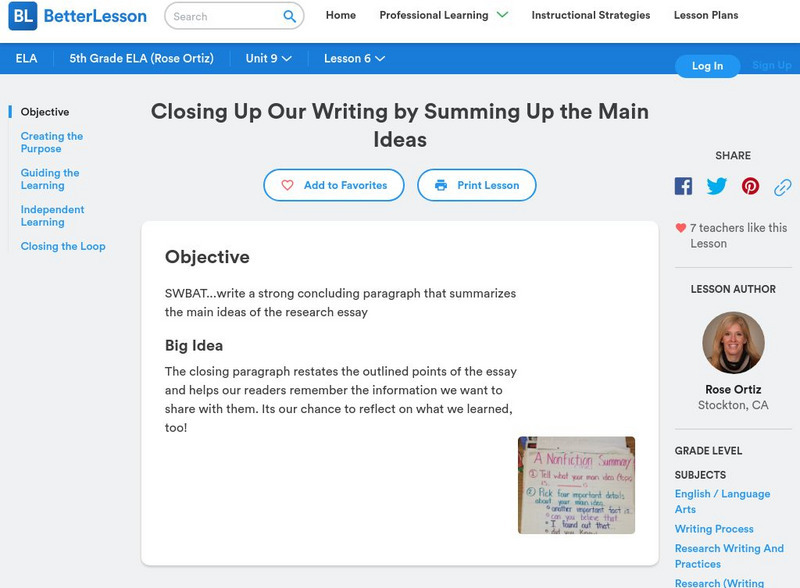





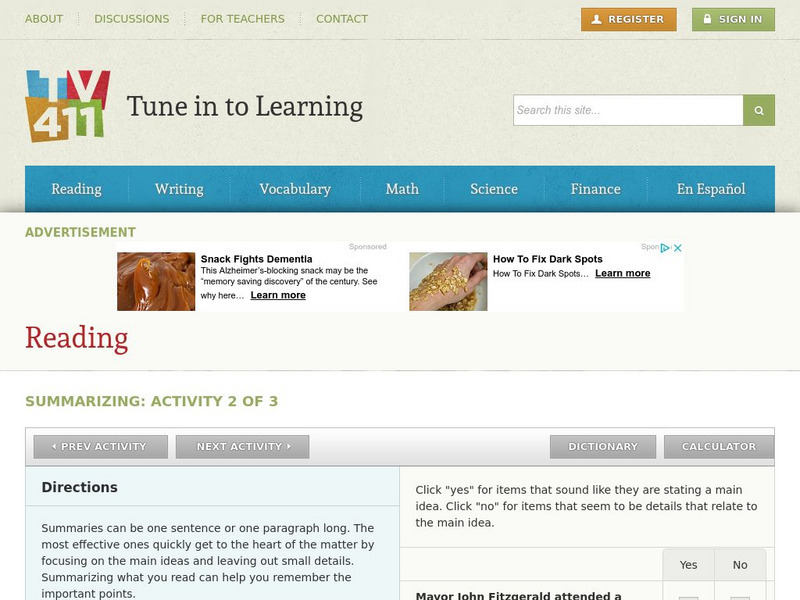
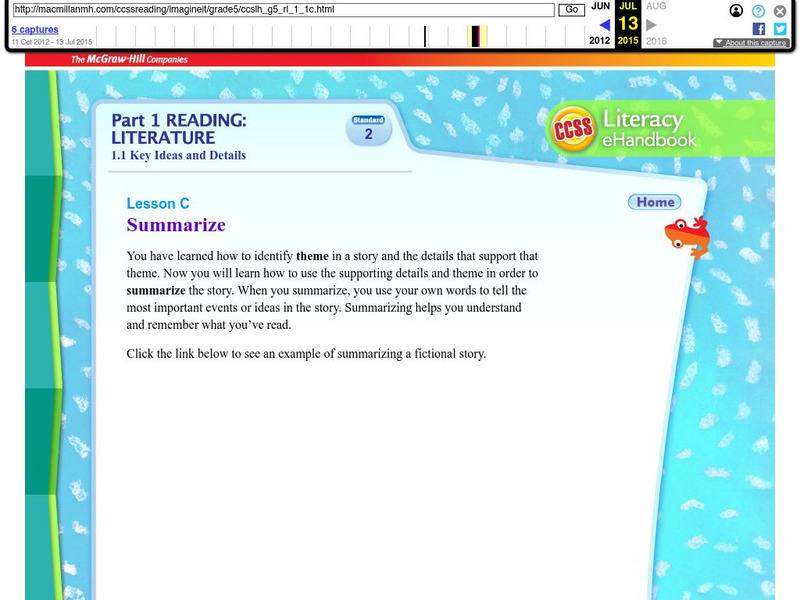



![Florida Center for Reading Research: Expository Text Structure: Summarizing [Pdf] Lesson Plan Florida Center for Reading Research: Expository Text Structure: Summarizing [Pdf] Lesson Plan](https://content.lessonplanet.com/knovation/original/509106-80e78b7399a2808435954652f1b4d966.jpg?1661786965)
